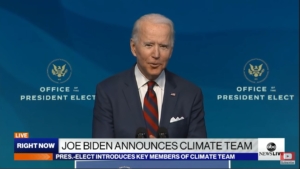Brexit Begins, Natural Gas’s U-Turn, and CBO Struggles
Here’s What You Need to Know
Last Monday the British government took its first baby step on the long march toward making Brexit a reality – Parliament passed a bill allowing UK Prime Minister Theresa May to trigger Article 50 and commence the process of leaving the EU. Getting this measure passed was the first of many struggles UK leaders will face in this process, and Downing Street has already announced that the Prime Minister does not intend to formally begin the process until sometime next month.
Brexit Bill’s Rocky Road: The Brexit bill did not come without some difficulty. Disagreements between the House of Commons and the House of Lords slowed the bill’s approval and led to both Houses rejecting proposed amendments. The two amendments would have offered EU natives already living in the EU extra legal protections in the UK and required a “meaningful” vote on the exact terms of the Brexit deal May’s government will negotiate. Though both Houses eventually agreed to the terms, they have much more difficult steps ahead of them and further disagreements are already beginning to present themselves.
Parliament’s Next Steps: Theresa May’s government may have the daunting task of actually negotiating the Brexit deal ahead of them, but Parliament also has a to-do list aimed at preparing the country for life after the EU. There are at least seven controversial pieces of legislation Parliament must pass, according to a leaked report from British foreign affairs officials. Each law requires massive overhauls of major policy areas impacted by Brexit, including immigration, taxes, agriculture, trade and customs regimes, fisheries, data protection, and sanctions. Adding to the challenge, all of these reforms must be completed within the next two years in order to be completed by the time the Brexit process closes out.
Subscribe to Receive Insights
"*" indicates required fields
Not-So-United Kingdom: Members of the regional governments of Northern Ireland and Scotland have both expressed desires to leave the United Kingdom in order to avoid Brexit and remain in the European Union. In Northern Ireland, the new leader of the Irish nationalist party Sinn Fein called for a referendum on Northern Ireland joining Ireland. Fifty-six percent of Northern Irish voters did vote to remain in the EU, but this move is likely just Sinn Fein using the opportunity to push for the Irish reunification policy they have traditionally promoted. Scottish First Minister Nicola Sturgeon also called for a second referendum on Scottish independence. Scottish leaders would hope to remain in the EU were they to gain independence, however European leaders have already stated that they would not accept an independent Scotland into the European Union. As impossible as it still may be for some to fathom, Brexit is really happening. The first tangible steps toward the two-year process of negotiating the UK’s exit from the EU has occurred. It’s worth noting that this bill is comparatively devoid of detailed policy, which will be negotiated by British and EU diplomats over the next two years. And, it still stumbled to the finish line only to be met with renewed criticism from parts of the UK. The unhappy conclusion for those tasked with shepherding Brexit into reality should be that it’s going to get worse before it gets better.
News You Can Use
SEXISM AND 2016: Researchers recently performed an experiment to analyze possible gender bias in political campaigns by reenacting the first president debate of the 2016 election, but swapping the candidates’ genders. The researchers’ hypothesis followed the conventional wisdom that sexism played a major role in the politics of 2016, most people would reject Trump’s bombastic claims and aggressive style if they were employed by a woman, and Clinton’s command of policy would be more impressive coming from a man. But, researchers were shocked to find that elements of what people found most inspiring about Clinton fell flat when she was played by a man, and tactics used by Trump that appeared to be uncoordinated stumbles looked more clever when he was played by a woman. This analysis is important for those on both sides of the aisle seeking to convince more women to run for office, and suggests sexism may not play as large a role in how candidates are perceived by voters as some believe.
NATURAL GAS’ U-TURN: Last December, a tanker of liquefied natural gas (LNG) heading from the United States to Asia made a sudden U-turn and instead docked in Mexico and unloaded its cargo. This event is just the latest signal of how the U.S. is radically altering the shale gas exports industry. Traditionally, the LNG business was almost entirely centered around long-term contracts with set destinations. But, now the American LNG industry is focused on seeking the best price at any one moment in time – shifting the business toward an emerging spot market akin to oil. The U.S. is set to become the world’s third largest LNG exporter by 2020, and how this market develops will play an important role in the American energy economy as well as the future of the global energy sector.
PURPLE IS OUT IN AMERICA: The 2016 presidential election was one of the most contentious and narrowly won in recent history. The data shows more than 61 percent of voters cast ballots in counties that went for either Trump or Clinton with at least 60 percent of the vote. This geographic sorting of political ideology has been progressing for the past several election cycles, with 50 percent of voters living in such counties in 2012 and 39 percent in 1992. The statistics seem to suggest that most counties are only becoming more entrenched in their chosen political ideology. If this trend continues, it could mean American politics are going to become even more polarizing than they are currently, and swing counties may become rarer and rarer with each election. See the map below:

HISTORY OF CBO’S INACCURACY: There’s been much debate and discussion about this week’s CBO score of the House Republican healthcare bill, and the agency’s methods and accuracy. The truth is, the CBO has its limitations and there have been large gaps between their original estimates and real historical data. For example, before Obamacare was enacted, the CBO estimated that by this year, the law’s exchanges would have enrolled 23 million Americans; they stuck with this number as recently as June 2015. However, the actual number is about nine million. CBO analysis of Obamacare repeal and replace legislation fails to take into account those who purchased insurance only to avoid fines and counts anyone who would willingly leave the insurance rolls as “losing” coverage. On the other hand, CBO likely overestimates the number of people who would drop out of Medicaid. The fines may have helped motivate people who are Medicaid eligible to join the program, but the absence of those fines seems unlikely to convince them to leave a free program. Overall, there are numerous flaws in how CBO has estimated figures for healthcare policy in the past and both parties would be better served by not over-focusing on the agency’s analysis.
JAPAN’S ECONOMIC FUTURE: ROBOTS: Most predictions about the future of the Japanese economy are bleak at the moment. But, financial adviser and publisher of the Gartman Letter, Dennis Gartman, is enthusiastically bullish on investment in Japan, thanks the nation’s robotics industry and its ability to turn a demographic liability into an asset. Japanese firms are increasing their profit margins by moving ahead of their foreign counterparts in transitioning their workforces to robots. The Japanese are even expanding this advantage beyond traditional manual and factory work expected to be taken on by robots. Last week, a Japanese advertising agency revealed a robot built to replace white collar workers, in this case advertising creative executives, with impressive results. With this long-term play in robotics, Japan’s economic future might not be as terrible as some suggest.



